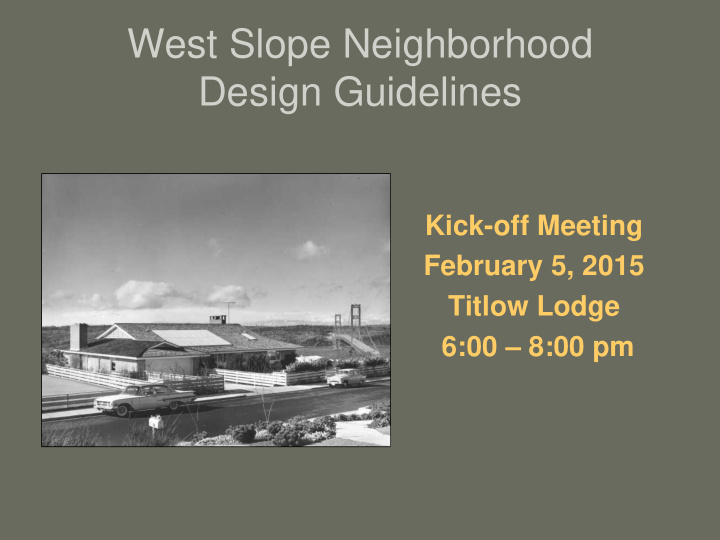



West Slope Neighborhood Design Guidelines Kick-off Meeting February 5, 2015 Titlow Lodge 6:00 – 8:00 pm
West Slope Neighborhood Design Guidelines Purpose of Meeting and Ground rules
Proposal Overview Proposal: Establish a conservation district to maintain neighborhood character through certain restrictions on building design, lot size and subdivision of existing lots. Key elements of WSNC proposal: • Houses shall be single-story with daylight basement • Establish a minimum lot size of 12,500 SF (zoning is 7500) • Subdivided lots shall extend from street to street • Trees and tall vegetation shall not obstruct views
Schedule: Key Dates November 18 West Slope Neighborhood Community Information Meeting February 5 Design Guidelines Kickoff • Discussion of guidelines content • Feedback March 11 Landmarks Preservation Commission presentation Set public hearing date March TBA West Slope Neighborhood Design Guidelines follow up
Schedule: Key Dates (continued) April 8 – Tentative Landmarks Preservation Commission public hearing April TBA Presentation to City Council Neighborhoods and Housing Committee July 1 Planning Commission public hearing
Schedule: Key Dates (continued) September 15 City Council Study Session September 15 City Council Public Hearing September 23 City Council Infrastructure, Planning and Sustainability Committee review September 29 City Council First Reading of ordinances October 6 City Council Final Reading of Ordinances October 31 Effective date of adopted amendments
Proposed district boundaries
Historical background • Narrowmoor Addn. 1 – recorded in 1944, 107 lots • Narrowmoor Addn. 2 – Recorded in 1944, 65 lots • Narrowmoor Addn. 3 – Recorded in 1947, Photo shows graded roads in 92 lots 1947, looking north
Historical background • Developed by Norwegian immigrant and builder Eivind Anderson • Designed by engineer David H. White • Houses designed by architects, custom- designed by builders, or built from stock plans
Historical background Many streets had been developed by 1951
Historical background 1951 Each house was carefully placed to 2015 maximize views
Historical background Orientation and responding to the topography was important
Historical background Streetscapes were important
Historical background Diversity within Modern architectural styles was important
Site design characteristics • Large lots, oriented east-west • Through lots (streets on both sides) • Houses sited on upside (east side) of lots • Extensive landscaping
House design characteristics • One story with daylight basements, with the main entry on the east side • Horizontal aspect with low pitched roofs • Display both Contemporary (Modern) and traditional Ranch styles
House design characteristics • Glazed rear facades • Extensive decks and outdoor space • Oriented toward views
Details – subtle entries, entry courts
Details – house fronts can be private
Details – garages are usually integrated with house; original doors are paneled
Details – natural materials, colors and textures are prized
Details – windows are large and horizontally oriented Front facade Rear facade
Details – doors are flush, sometimes with sidelights
Design guidelines for mid-century modern districts • Arapahoe Acres , Englewood, CO, NR Historic District – extensive design guidelines; voluntary design review • Oak Hills , Washington Co., OR, NR Historic District – no design guidelines; no review • Sea Ranch , Sonoma Co., CA, no historic designation – extensive, mandatory design guidelines • Eichler Homes , Sunnyvale, CA, no historic designation – extensive, mandatory design guidelines
Design guidelines - Application • Design for new construction • Design of additions to footprints of existing homes • Demolition of existing homes
Design guidelines – identify elements
Design guidelines – identify characteristics
Design guidelines – identify characteristics
Design guidelines - height For example: Building heights must be no higher than the average height of adjacent buildings Buildings are one story with a daylight basement
Design guidelines - massing and scale For example: Residential structures shall not exceed a single, main level and a daylight basement Preferred massing is simple, with rectangular, L-shaped or U-shaped footprints
Design guidelines - exterior cladding and materials For example: New materials will be compatible with existing materials in the neighborhood, including board and batten, brick and masonry veneer, striated cedar shingles, and horizontal board
Design guidelines – roof shape and eaves For example: Roof forms will be compatible with prevailing low- pitched and flat roofs Houses with parapet roofs will not be allowed
Design guidelines – fenestration patterns For example: Fenestration patterns will reflect or be compatible with the prevailing patterns of Front facade horizontal windows and emphasize privacy on the front façade; rear facades may be heavily glazed Rear facade
Design guidelines - fenestration patterns
Additional guideline subjects to be addressed: • Architectural details • Additions • Main entrances • Accessory structures and parking • Site plan and layout
West Slope Neighborhood Design Guidelines Kick-off Meeting February 5, 2015 Titlow Lodge 6:00 – 8:00 pm
Recommend
More recommend